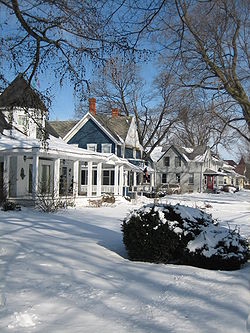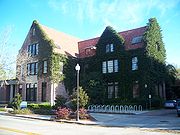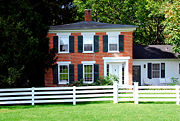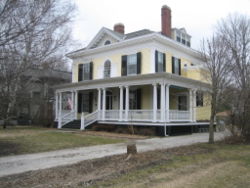
Historic district (United States)
Encyclopedia

United States
The United States of America is a federal constitutional republic comprising fifty states and a federal district...
, a historic district is a group of buildings, properties
Property
Property is any physical or intangible entity that is owned by a person or jointly by a group of people or a legal entity like a corporation...
, or sites that have been designated by one of several entities on different levels as historically or architecturally significant. Buildings, structures, objects and sites within a historic district are normally divided into two categories, contributing
Contributing property
In the law regulating historic districts in the United States, a contributing resource or contributing property is any building, structure, or object which adds to the historical integrity or architectural qualities that make the historic district, listed locally or federally, significant...
and non-contributing. Districts greatly vary in size: some have hundreds of structures, while others have just a few.
The U.S. federal government designates historic districts through the United States Department of Interior under the auspices of the National Park Service
National Park Service
The National Park Service is the U.S. federal agency that manages all national parks, many national monuments, and other conservation and historical properties with various title designations...
. Federally designated historic district
Historic district
A historic district or heritage district is a section of a city which contains older buildings considered valuable for historical or architectural reasons. In some countries, historic districts receive legal protection from development....
s are listed on the National Register of Historic Places
National Register of Historic Places
The National Register of Historic Places is the United States government's official list of districts, sites, buildings, structures, and objects deemed worthy of preservation...
(NRHP), but listing on the NRHP imposes no restrictions on what property owners may do with a designated property. State
U.S. state
A U.S. state is any one of the 50 federated states of the United States of America that share sovereignty with the federal government. Because of this shared sovereignty, an American is a citizen both of the federal entity and of his or her state of domicile. Four states use the official title of...
-level historic districts may follow similar criteria (no restrictions) or may require adherence to certain historic rehabilitation standards. Local historic district designation offers, by far, the most legal protection for historic properties because most land use decisions are made at the local level. Local districts are generally administered by the county or municipal government. The tendency of local districts to place restrictions on property owners causes them to be the targets of the most resistance from the public.
The first historic district was located in Charleston, South Carolina
Charleston, South Carolina
Charleston is the second largest city in the U.S. state of South Carolina. It was made the county seat of Charleston County in 1901 when Charleston County was founded. The city's original name was Charles Towne in 1670, and it moved to its present location from a location on the west bank of the...
and predated the first U.S. federal government designated district by more than 30 years. Other local historic districts appeared in succeeded years, and in 1966 the federal government
Federal government of the United States
The federal government of the United States is the national government of the constitutional republic of fifty states that is the United States of America. The federal government comprises three distinct branches of government: a legislative, an executive and a judiciary. These branches and...
created the National Register of Historic Places soon after a report from the U.S. Conference of Mayors stated Americans suffered from "rootlessness." By the 1980s there were thousands of federally designated historic districts.
Property types

In addition to the two types of classification within historic districts, properties listed on the National Register of Historic Places are classified into five broad categories. They are, building, structure, site, district and object; each one has a specific definition in relation to the National Register. All but the eponymous district category are also applied to historic districts listed on the National Register.
Federal-level
A listing on the National Register of Historic Places is governmental acknowledgment of a historic district. However, the Register is "an honorary status with some federal financial incentives." The National Register of Historic Places defines a historic district per U.S. federal lawNational Historic Preservation Act of 1966
The National Historic Preservation Act is legislation intended to preserve historical and archaeological sites in the United States of America...
, last revised in 2004. According to the Register definition a historic district is:
"a geographically definable area, urban or rural, possessing a significant concentration, linkage, or continuity of sites, buildings, structures, or objects united by past events or aesthetically by plan or physical development. A district may also comprise individual elements separated geographically but linked by association or history."
Districts established under U.S. federal guidelines generally begin the process of designation through a nomination to the National Register of Historic Places. The National Register is the official recognition by the U.S. government of cultural resources
Cultural resources management
In the broadest sense, Cultural Resources Management is the vocation and practice of managing cultural resources, such as the arts and heritage. It incorporates Cultural Heritage Management which is concerned with traditional and historic culture. It also delves into the material culture of...
worthy of preservation. While designation through the National Register does offer a district or property some protections, it is only in cases where the threatening action involves the federal government. If the federal government is not involved, then the listing on the National Register provides the site, property or district no protections. For example, if company A wants to tear down the hypothetical Smith House and company A is under contract with the state government of Illinois, then the federal designation would offer no protections. If, however, company A was under federal contract the Smith House would be protected. A federal designation is little more than recognition by the government that the resource is worthy of preservation.
In general, the criteria for acceptance to the National Register are applied consistently, but there are considerations for exceptions to the criteria and historic districts have influence on some of those exceptions. Usually, the National Register does not list religious structures, moved structures, reconstructed structures, or properties that have achieved significance within the last 50 years. However, if a property falls into one of those categories and are "integral parts
Contributing property
In the law regulating historic districts in the United States, a contributing resource or contributing property is any building, structure, or object which adds to the historical integrity or architectural qualities that make the historic district, listed locally or federally, significant...
of districts that do meet the criteria" then an exception allowing their listing will be made. Historic district listings, like all National Register nominations, can be rejected on the basis of owner disapproval. In the case of historic districts, a majority of owners must object in order to nullify a nomination to the National Register of Historic Places. If such an objection occurred, then the nomination would become a determination of National Register eligibility only.
State-level

U.S. state
A U.S. state is any one of the 50 federated states of the United States of America that share sovereignty with the federal government. Because of this shared sovereignty, an American is a citizen both of the federal entity and of his or her state of domicile. Four states use the official title of...
governments have a listing similar to the National Register of Historic Places. State listings can have similar benefits to federal designation, such as granting qualification and tax incentives. In addition, the property can become protected under specific state laws. The laws can be similar or different from the federal guidelines that govern the National Register. A state listing of a historic district on a "State Register of Historic Places," usually by the State Historic Preservation Office, can be an "honorary status," much like the National Register. For example, in Nevada
Nevada
Nevada is a state in the western, mountain west, and southwestern regions of the United States. With an area of and a population of about 2.7 million, it is the 7th-largest and 35th-most populous state. Over two-thirds of Nevada's people live in the Las Vegas metropolitan area, which contains its...
, listing in the State Register places no limits on property owners. In contrast, state law in Tennessee
Tennessee
Tennessee is a U.S. state located in the Southeastern United States. It has a population of 6,346,105, making it the nation's 17th-largest state by population, and covers , making it the 36th-largest by total land area...
requires that property owners within historic districts follow a strict set of guidelines, from the U.S. Department of Interior, when altering their properties. Though, according to the National Historic Preservation Act of 1966, all states must have a State Historic Preservation Office, not all states must have a "state historic district" designation. As of 2004, for example, the state of North Carolina
North Carolina
North Carolina is a state located in the southeastern United States. The state borders South Carolina and Georgia to the south, Tennessee to the west and Virginia to the north. North Carolina contains 100 counties. Its capital is Raleigh, and its largest city is Charlotte...
had no such designation.
Local-level
_by_david_shankbone.jpg)
County (United States)
In the United States, a county is a geographic subdivision of a state , usually assigned some governmental authority. The term "county" is used in 48 of the 50 states; Louisiana is divided into parishes and Alaska into boroughs. Parishes and boroughs are called "county-equivalents" by the U.S...
or the municipal level; both entities are involved in land use decisions.
According to the National Park Service, historic districts are one of the oldest forms of protection for historic properties. The city of Charleston, South Carolina
Charleston, South Carolina
Charleston is the second largest city in the U.S. state of South Carolina. It was made the county seat of Charleston County in 1901 when Charleston County was founded. The city's original name was Charles Towne in 1670, and it moved to its present location from a location on the west bank of the...
is credited with beginning the modern day historic districts movement. In 1931 Charleston enacted an ordinance
Local ordinance
A local ordinance is a law usually found in a municipal code.-United States:In the United States, these laws are enforced locally in addition to state law and federal law.-Japan:...
which designated an "Old and Historic District" which was administered by a Board of Architectural Review. Charleston's early ordinance reflected the strong protection that local historic districts often enjoy under local law. It asserted that no alteration could be made to any architectural features which could be viewed by the public from the street. Other local historic districts, such as that in Savannah, Georgia
Savannah, Georgia
Savannah is the largest city and the county seat of Chatham County, in the U.S. state of Georgia. Established in 1733, the city of Savannah was the colonial capital of the Province of Georgia and later the first state capital of Georgia. Today Savannah is an industrial center and an important...
, predate the Register by 10 years or more as well.
Local historic districts are most likely to generate resistance because of the restrictions they tend to place on property owners. Local laws can cause residents to "manage … obligations to comply with (local historic district) ordinances." Examples of local preservation laws can be found in Nashville, Tennessee
Nashville, Tennessee
Nashville is the capital of the U.S. state of Tennessee and the county seat of Davidson County. It is located on the Cumberland River in Davidson County, in the north-central part of the state. The city is a center for the health care, publishing, banking and transportation industries, and is home...
, where the city has adopted the stricter of two sets of criteria. In Nashville, per state and local law, building design criteria for structures that are designated as parts of local "preservation districts" are derived from the U.S. Secretary of Interior's Standards for the Rehabilitation of Historic Buildings. For property owners within these preservation districts to make alterations they must adhere to a set of guidelines which concern roof form and materials, front and side porches (no screens
Window screen
A window screen, insect screen or bug screen is a metal wire, fiberglass, or other synthetic fiber mesh, stretched in a frame of wood or metal, designed to cover the opening of an open window. Its primary purpose is to keep leaves, debris, insects, birds, and other animals from entering a building...
allowed), shape, style and placement of windows and doors, construction materials (no hardboard
Hardboard
Hardboard, also called high-density fiberboard , not to be confused with 'hardwood', is a type of fiberboard, which is an engineered wood product....
, masonite
Masonite
Masonite is a type of hardboard invented by William H. Mason.-History:Masonite was invented in 1924 in Laurel, Mississippi, by William H. Mason. Mass production started in 1929. In the 1930s and 1940s Masonite was used for many applications including doors, roofing, walls, desktops, and canoes...
, aluminum, or vinyl
Vinyl siding
Vinyl siding is plastic exterior cladding for a house, used for decoration and weatherproofing, as an alternative to traditional wood siding or other materials such as aluminum or fiber cement siding. It is an engineered product, manufactured primarily from polyvinyl chloride, or PVC, resin, giving...
cladding allowed), lighting fixtures, fences, paving, and paint color (for masonry
Masonry
Masonry is the building of structures from individual units laid in and bound together by mortar; the term masonry can also refer to the units themselves. The common materials of masonry construction are brick, stone, marble, granite, travertine, limestone; concrete block, glass block, stucco, and...
structures).
Resistance to historic district designations and expansions is fairly widespread. In New York City
New York City
New York is the most populous city in the United States and the center of the New York Metropolitan Area, one of the most populous metropolitan areas in the world. New York exerts a significant impact upon global commerce, finance, media, art, fashion, research, technology, education, and...
, in 2006, residents resisted the designation of historic district for Fieldston
Fieldston, Bronx
Fieldston is a section of the Riverdale section of the Bronx, New York City. It is bounded by Manhattan College Parkway to the south, Henry Hudson Parkway to the west, 250th Street to the north and Broadway to the east....
, a Bronx neighborhood, because of the increase in regulations and decrease in property values associated with historic districts. Historic district advocates claim that the designation does not harm property values, and they claim studies prove they increase property values. Yet, actual real estate investors generally disagree. The studies that show property value increases are flawed by not accounting for value trends prior to historic district designation. Historic district designations are usually introduced after economic pressures raise property values and provide investors with incentives for demolition. In April 2007 residents and politicians in Rochester, New Hampshire
Rochester, New Hampshire
Rochester is a city in Strafford County, New Hampshire, United States. As of the 2010 census, the city population was 29,752. The city includes the villages of East Rochester and Gonic. Rochester is home to Skyhaven Airport and the annual Rochester Fair....
resisted a historic district boundary increase. The local newspaper called the increase "overreaching" and noted regulations on paint color and interior renovations as reasons for its opposition to the proposal.
Significance

Landmark
This is a list of landmarks around the world.Landmarks may be split into two categories - natural phenomena and man-made features, like buildings, bridges, statues, public squares and so forth...
sites. Preservationists came to the view that districts should be more encompassing, blending together a mesh of structures, streets, open space and landscaping to define the historical character of a historic district.
As early as 1981 the National Trust for Historic Preservation
National Trust for Historic Preservation
The National Trust for Historic Preservation is an American member-supported organization that was founded in 1949 by congressional charter to support preservation of historic buildings and neighborhoods through a range of programs and activities, including the publication of Preservation...
identified 882 American cities and towns that had some form of "historic district zoning" in place; local laws meant specifically to protect historic districts. Before 1966, historic preservation in the United States was in its infancy. That year the U.S. Conference of Mayors penned an influential report which concluded, in part, that Americans suffered from a sense of "rootlessness." They recommended historic preservation
Historic preservation
Historic preservation is an endeavor that seeks to preserve, conserve and protect buildings, objects, landscapes or other artifacts of historical significance...
to help provide Americans with a sense of orientation. The creation of the National Register of Historic Places in 1966, on the heels of the report, helped to instill that sense of orientation the mayors were looking for. The mayors also recommended that any historic preservation program not focus solely on individual properties but also on "areas and districts which contain special meaning for the community." Local, state and federal historic districts now account for thousands of historic property listings at all levels of government.
See also
- Adaptive reuseAdaptive reuseAdaptive reuse refers to the process of reusing an old site or building for a purpose other than which it was built or designed for. Along with brownfield reclamation, adaptive reuse is seen by many as a key factor in land conservation and the reduction of urban sprawl...
- Conservation areaConservation areaA conservation areas is a tract of land that has been awarded protected status in order to ensure that natural features, cultural heritage or biota are safeguarded...
- Historic preservationHistoric preservationHistoric preservation is an endeavor that seeks to preserve, conserve and protect buildings, objects, landscapes or other artifacts of historical significance...
- ZoningZoningZoning is a device of land use planning used by local governments in most developed countries. The word is derived from the practice of designating permitted uses of land based on mapped zones which separate one set of land uses from another...

